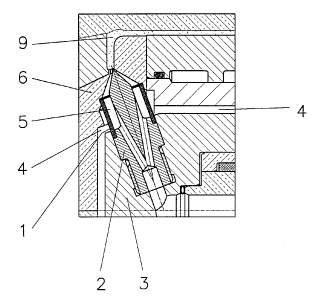Some of the information on this Web page has been provided by external sources. The Government of Canada is not responsible for the accuracy, reliability or currency of the information supplied by external sources. Users wishing to rely upon this information should consult directly with the source of the information. Content provided by external sources is not subject to official languages, privacy and accessibility requirements.
Any discrepancies in the text and image of the Claims and Abstract are due to differing posting times. Text of the Claims and Abstract are posted:
| (12) Patent: | (11) CA 2284623 |
|---|---|
| (54) English Title: | MOVABLE MOLTEN MASS GUIDE SLEEVE TO COMPENSATE FOR TEMPERATURE-DEPENDENT EXPANSION BETWEEN THE HOT CHANNEL AND THE MOLD FEED ORIFICE |
| (54) French Title: | MANCHON MOBILE DISTRIBUTEUR DE LA MATIERE PLASTIQUE FONDUE PERMETTANT DE COMPENSER LA DILATATION THERMIQUE ENTRE LE CANAL DE CAROTTE CHAUFFE ET L'ENTREE DU MOULE |
| Status: | Deemed expired |
| (51) International Patent Classification (IPC): |
|
|---|---|
| (72) Inventors : |
|
| (73) Owners : |
|
| (71) Applicants : |
|
| (74) Agent: | FETHERSTONHAUGH & CO. |
| (74) Associate agent: | |
| (45) Issued: | 2008-03-25 |
| (86) PCT Filing Date: | 1999-01-19 |
| (87) Open to Public Inspection: | 1999-07-29 |
| Examination requested: | 2003-12-16 |
| Availability of licence: | N/A |
| (25) Language of filing: | English |
| Patent Cooperation Treaty (PCT): | Yes |
|---|---|
| (86) PCT Filing Number: | PCT/CH1999/000023 |
| (87) International Publication Number: | WO1999/037461 |
| (85) National Entry: | 1999-09-20 |
| (30) Application Priority Data: | ||||||
|---|---|---|---|---|---|---|
|
The invention relates to a dynamic molten mass guide sleeve
with an articulated motion to compensate for differences in
expansions in the inner flow hot channel with air gap
insulation in injection molding of plastics. To date, fixed
molten mass guide sleeves required extrremely stringent
location deviations and often led to mold cavity ruptures or
leakage as a result of differences in expansions. The
inventive sleeve is fitted with peripheral sealing lips on
both ends and is mounted in-between the hot channel (3) and
the mold cavity (6). Said sleeve compensates for heat
expansions and enables well-defined temperature separation
in the mold feed orifice area of the injection mold by
sealing the air gap (4).
L'invention concerne un manchon dynamique distributeur de la matière plastique fondue, du type articulé, destiné à compenser les différences de dilatation dans le canal chauffant à écoulement interne isolé par des fentes d'aération, dans des moules d'injection pour transformer les matières plastiques. Les manchons de ce type, ancrés à demeure, revendiqués jusqu'à présent, présentaient des tolérances de montage extrêmement serrées et entraînaient souvent une rupture d'empreinte ou bien des fuites par suite de différences de dilatation. Le manchon décrit dans la présente invention, lequel comporte des lèvres d'étanchéité périphériques à ses deux extrémités et est monté entre le canal chauffant (3) et l'empreinte (6), compense le phénomène de dilatation thermique et permet, grâce à une étanchéification de la fente d'aération (4) une séparation thermique plus nette dans la région de l'entrée du moule d'injection.
Note: Claims are shown in the official language in which they were submitted.
Note: Descriptions are shown in the official language in which they were submitted.

For a clearer understanding of the status of the application/patent presented on this page, the site Disclaimer , as well as the definitions for Patent , Administrative Status , Maintenance Fee and Payment History should be consulted.
| Title | Date |
|---|---|
| Forecasted Issue Date | 2008-03-25 |
| (86) PCT Filing Date | 1999-01-19 |
| (87) PCT Publication Date | 1999-07-29 |
| (85) National Entry | 1999-09-20 |
| Examination Requested | 2003-12-16 |
| (45) Issued | 2008-03-25 |
| Deemed Expired | 2014-01-21 |
There is no abandonment history.
Note: Records showing the ownership history in alphabetical order.
| Current Owners on Record |
|---|
| PROTOOL AG |
| Past Owners on Record |
|---|
| CHRISTEN, ANDREAS |